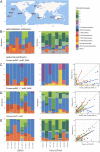A Metagenomic and Amplicon Sequencing Combined Approach Reveals the Best Primers to Study Marine Aerobic Anoxygenic Phototrophs
- PMID: 37148309
- PMCID: PMC10497671
- DOI: 10.1007/s00248-023-02220-y
A Metagenomic and Amplicon Sequencing Combined Approach Reveals the Best Primers to Study Marine Aerobic Anoxygenic Phototrophs
Abstract
Studies based on protein-coding genes are essential to describe the diversity within bacterial functional groups. In the case of aerobic anoxygenic phototrophic (AAP) bacteria, the pufM gene has been established as the genetic marker for this particular functional group, although available primers are known to have amplification biases. We review here the existing primers for pufM gene amplification, design new ones, and evaluate their phylogenetic coverage. We then use samples from contrasting marine environments to evaluate their performance. By comparing the taxonomic composition of communities retrieved with metagenomics and with different amplicon approaches, we show that the commonly used PCR primers are biased towards the Gammaproteobacteria phylum and some Alphaproteobacteria clades. The metagenomic approach, as well as the use of other combinations of the existing and newly designed primers, show that these groups are in fact less abundant than previously observed, and that a great proportion of pufM sequences are affiliated to uncultured representatives, particularly in the open ocean. Altogether, the framework developed here becomes a better alternative for future studies based on the pufM gene and, additionally, serves as a reference for primer evaluation of other functional genes.
Keywords: AAP bacteria; Amplicon sequencing; Metagenomics; Primer evaluation; pufM gene.
© 2023. The Author(s).
Conflict of interest statement
The authors declare no competing interests.
Figures



References
-
- Duarte CM (2015) Seafaring in the 21st century: the Malaspina 2010 circumnavigation expedition. Limnol Oceanogr Bull 24:11–14. 10.1002/lob.10008
Publication types
MeSH terms
Substances
Grants and funding
LinkOut - more resources
Full Text Sources
Miscellaneous

